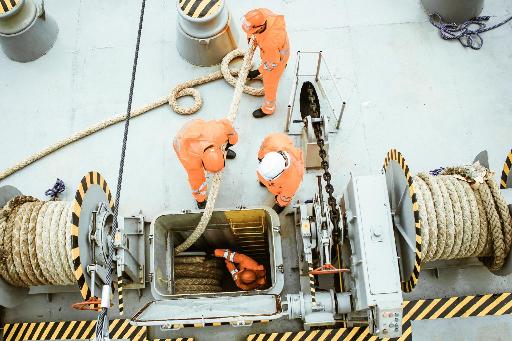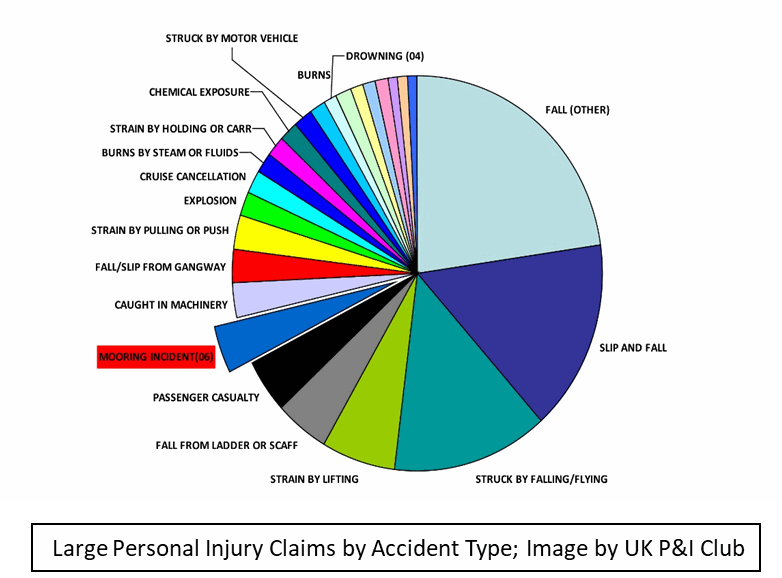MOORING ACCIDENTS (Case Studies)
Little finger caught in rotating winch (2018) – While at anchor in fair weather, some deck crew were performing maintenance on the mooring winches. A crew member had just greased one the winches. He asked another crew member to start the winch and rotate so he could wipe out the excess grease. The assisting crew member started the winch, but almost immediately the greasing crew cried out to him to stop the winch. His finger had been caught in the machinery and even though he had gloves on, his small finger was severely injured. After his first aid was administered, he was evacuated ashore where the tip of his small finger had to be amputated. The company investigation found that in previous maneuvers to remove excess grease a long flat paint brush had been used. In this incident, the crew member used a small piece of cloth to wipe out the excess grease, bringing his hand close to a known hazard. - MARS Report No. 311 September 2018.
Fatal Crush Injury from Mooring Line (2006) – A 15,000 Dwt vessel ship was unmooring and had singled up to one head line and back spring forward with a tug fast on the starboard quarter. The bridge requested ‘let go everything forward’. It was confirmed as let go but not clear. As the ship moved off the berth, an AB who was standing in the bight of the spring line suffered a fatal crush injury as the line immediately tightened when it snagged on an underwater obstruction on the jetty. The line moved up to his waist and he was dragged around the mooring bitts and to the ship’s side fairlead. -21st Century Seamanship 2015.

UNDERSTANDING MOORING INCIDENTS
On one of its 2016 press releases, the UK P&I Club examined common mooring practices and highlighted relevant actions that can reduce the risk of accidents. They stated that mooring injuries are the seventh most frequent cause of personal injuries, and are the third most expensive per claim, emphasizing the importance of taking proper safety measures. Many of mooring accidents have occurred during the handling of UK P&I Club ropes/wires, where ropes/wires have parted (53%) or where ropes/wires have jumped/slipped off drum ends/bitts (42%) or where actual equipment fails (5%).
Records show that mooring is indeed one of the most difficult, complex, and dangerous jobs on board. Among several personal injury claims by accident types while on board, mooring incidents appear to be the seventh highest in frequency. Commonly, such mooring incidents involve leg injuries (23 %), death (14 %), back damage (14 %), and some other multiple injuries. Many accidents have led to severe injury and/or death of seafarers. Accidents come unexpectedly. Things may seem safe at first. Yet, accidents with unpredicted severe consequences may suddenly occur even during routine procedures. Full control over your mooring operation may be obsolete and dependent on several factors; including your crew’s skill and knowledge on safe operations, your vessel’s equipment status, and even your team’s communication before and during mooring. While this is the case, it would help if the ship management and its crew can prepare and plan a safer mooring. Safety must be improved. Risk of mooring accidents must (and can actually) be reduced. As stated by the UK P&I Club, the vessel and equipment must be maintained to a high standard all personnel should be adequately trained with the correct personal protective equipment, the correct procedures should be in place, work permits issued, and all mooring operations should be supervised by a competent person.
TRAINING IN MOORING OPERATIONS, PERSONAL SAFETY
When mooring, accidents may be prevented. By training, the crew can improve the safety while mooring. Training in mooring operations should be incorporated into the vessels’ regular training schedule and include all personnel who are to be involved. GigaMare Inc’s training on safe mooring operation aims to help ship management and its crew prepare and plan a safer mooring. The training presents tools and knowledge focusing on how to prevent accidents when mooring. Vital focus of the course includes proper use of mooring and anchoring equipment, risk assessment and preparation for a mooring operation, as well as safety on performing greasing tasks.
Be well prepared, know the risks, operate as a team and look out for each other – these will make a difference.

.png)